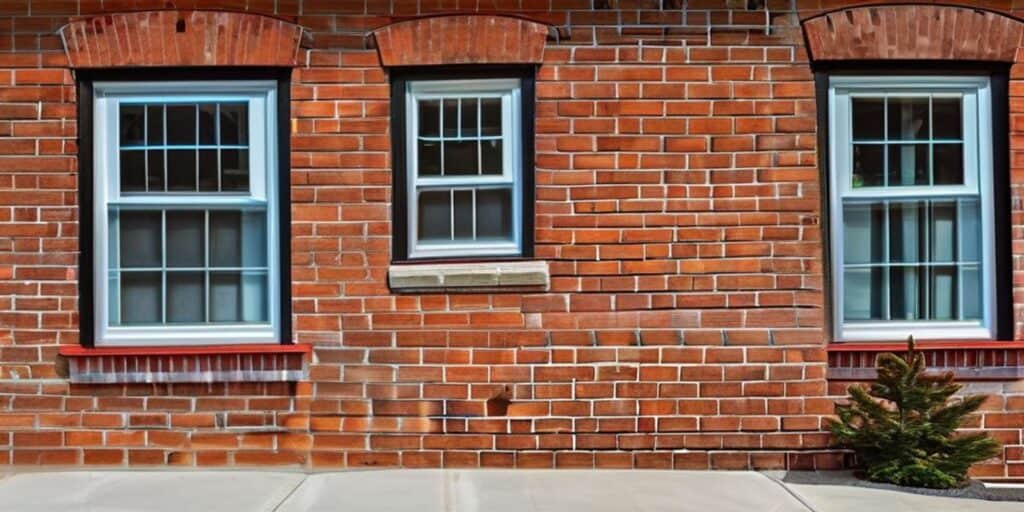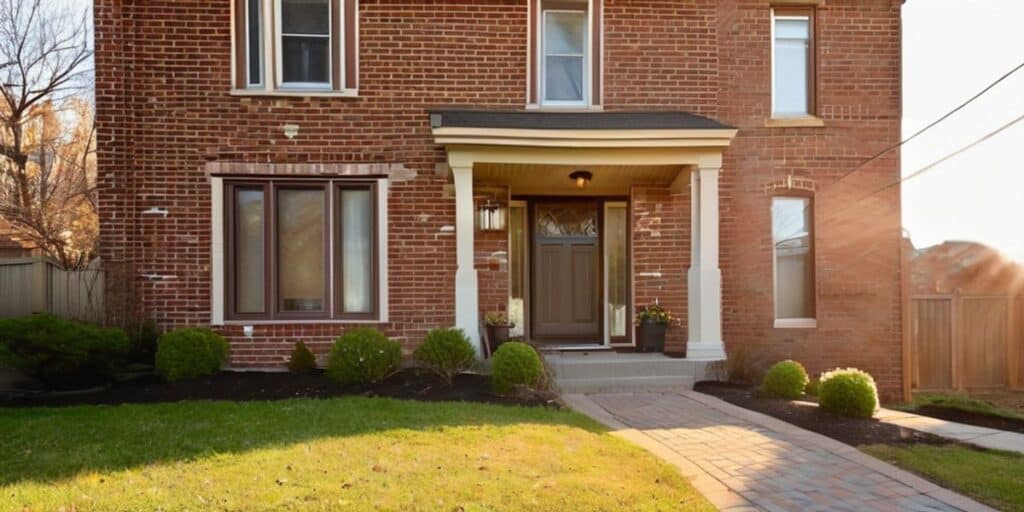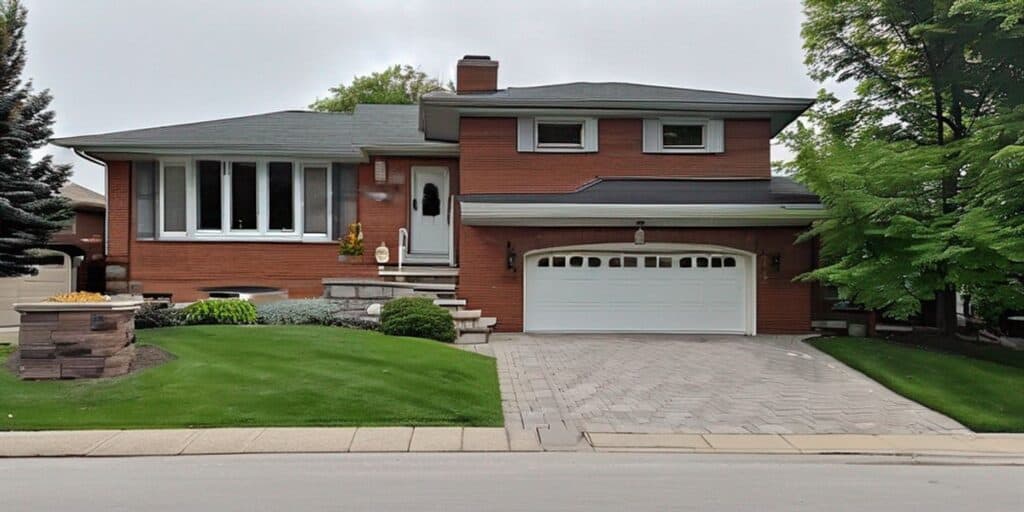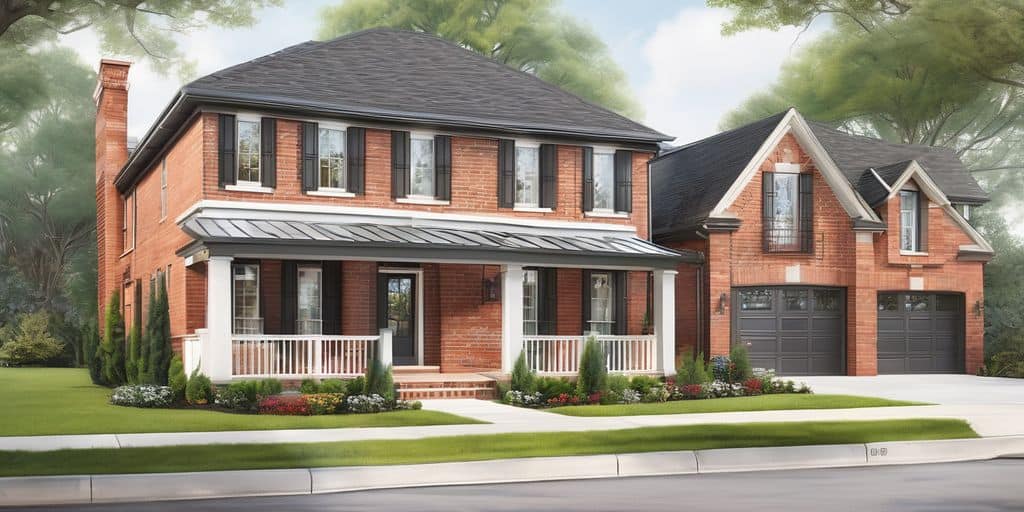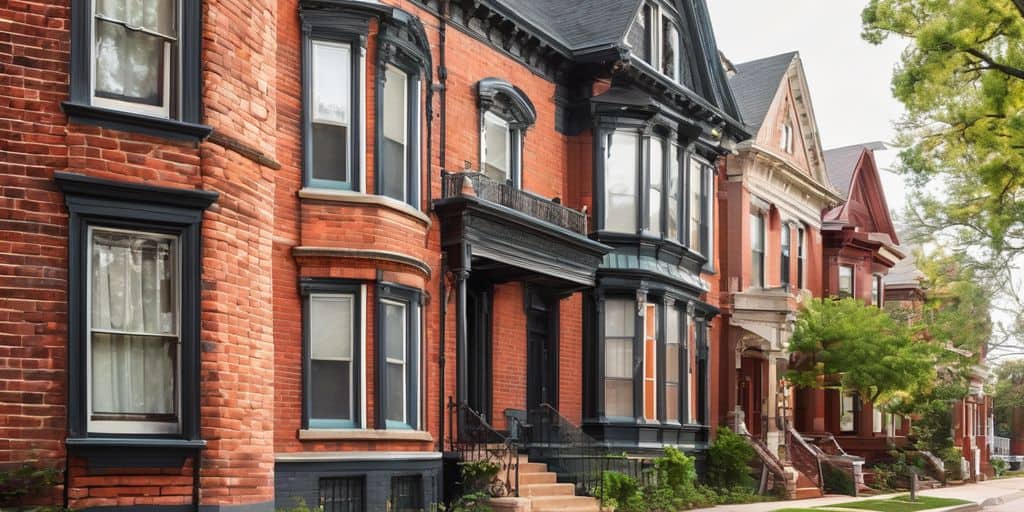In the picturesque city of Hamilton, painting brick houses is an art that requires not just aesthetic consideration but also a keen understanding of moisture challenges. With over three decades of experience in working with historic and heritage properties, I’ve honed my expertise in brickwork, particularly in utilizing lime mortar and addressing the unique needs of Georgian, Edwardian, and Victorian structures. In this article, we delve into the complexities of managing moisture in brick houses, drawing on insights from seasoned professionals and the latest best practices for maintenance and repair.
Key Takeaways
- Understanding moisture challenges in brick houses is crucial for long-term preservation, especially given the impact of weather extremes in Hamilton.
- Routine cleaning and maintenance, including options like pressure washing and its alternatives, play a vital role in preventing moisture issues.
- Repair and restoration must balance structural integrity with aesthetic fidelity, utilizing matching mortar and respecting the property’s heritage.
- Selecting the right materials, like quality masonry paint and lime mortar, is essential for compatibility with existing brickwork and overall durability.
- Navigating disputes requires thorough documentation, understanding legal avenues, and seeking expert opinions to ensure satisfactory resolutions.
Understanding Moisture Challenges in Brick Houses
The Impact of Weather Extremes on Brickwork
Brick houses in Hamilton are renowned for their durability and aesthetic appeal. However, they are not immune to the challenges posed by weather extremes. Frequent fluctuations in temperature and humidity can significantly affect the integrity of brickwork.
- Temperature swings can cause bricks to expand and contract, leading to cracks and structural damage.
- Excessive moisture from rain or snow can seep into small fissures, potentially causing the bricks to spall or the mortar to deteriorate.
- In winter, the freeze-thaw cycle can be particularly damaging as water trapped in brickwork expands when frozen.
It is crucial to monitor the condition of brickwork regularly, especially after severe weather events, to identify any potential issues early on.
Understanding the specific challenges in Hamilton, such as the impact of lake-effect snow from nearby Lake Ontario, can help homeowners prepare and protect their properties. Proactive measures include sealing bricks, ensuring proper drainage, and timely repairs to prevent minor issues from escalating.
Identifying Signs of Moisture Damage
Recognizing the signs of moisture damage in brick houses is crucial for timely intervention and repair. Early detection can save homeowners from costly repairs in the future. Here are some common indicators of moisture issues:
- Discoloration or staining on brickwork or mortar
- Efflorescence, which is the white powdery substance on bricks
- Mold or mildew presence, indicating trapped moisture
- Peeling or blistering paint, a sign of moisture beneath the surface
- Dampness on interior walls, which may suggest exterior moisture penetration
Moisture damage can manifest in various forms, and it’s essential to address these signs promptly. For instance, a leaning chimney in Hamilton’s historic neighborhoods could be a telltale sign of underlying moisture problems affecting the structure’s stability.
Proactive maintenance, such as regular inspections and sealing of brickwork, can prevent the progression of moisture damage. It’s advisable to consult professionals for significant issues, especially when dealing with heritage properties where preservation is key.
The Role of Mortar in Moisture Protection
Mortar plays a critical role in the integrity and moisture protection of brick houses. Its primary function is to bond bricks together, but it also serves as a key barrier against water infiltration. Properly mixed and applied mortar can significantly reduce moisture issues in brickwork by providing several protective features:
- Water-retaining capacity, which is crucial for the longevity of the mortar and the overall wall structure.
- Enhanced adhesion to bricks, ensuring a tight seal that prevents water from seeping through gaps.
- Flexibility to accommodate slight movements within the brick structure without cracking.
It’s important to understand that the composition of mortar can affect its performance. For instance, the addition of starch ethers can improve the water-retaining capacity of mortar, while biological admixtures like microbial extracellular polysaccharides can enhance viscosity and water retention. These properties are essential for maintaining the structural integrity and aesthetic appeal of brick houses in varying weather conditions.
When selecting materials for mortar repair or restoration, it’s essential to consider the compatibility with the existing brickwork to ensure effective moisture protection.
In Hamilton, the fluctuating temperatures and weather conditions can put additional stress on brick houses, making the role of mortar even more significant. Regular inspection and maintenance of mortar joints can prevent costly repairs and extend the life of the brickwork.
Best Practices for Cleaning and Maintenance
When to Opt for Pressure Washing
Deciding when to use pressure washing as part of the maintenance routine for a painted brick house is crucial. Proactive maintenance is essential for preserving painted bricks. Regular cleaning can address common issues like efflorescence, peeling paint, and mold, ultimately extending the life of the brickwork. Here are some indicators that it might be time to consider pressure washing:
- Visible accumulation of dirt, grime, or biological growth such as moss or algae
- Presence of stains from atmospheric pollutants or bird droppings
- Before repainting, to ensure the paint adheres properly to clean surfaces
Properly preparing brick surfaces for painting is a multi-step process. Key steps include gentle washing, avoiding damage to the bricks, and meticulous preparation to ensure lasting charm. It’s important to ensure thorough drying of the brickwork before any painting begins.
Remember, while pressure washing can be highly effective, it must be done correctly to avoid damaging the bricks. Incorrect pressure or technique can erode mortar and harm the brick surface.
In Hamilton, the fluctuating temperatures and weather conditions can increase the need for such maintenance. While not a landmark, the local climate itself serves as a reminder of the importance of regular upkeep to protect the integrity and aesthetics of brick houses.
Alternatives to High-Pressure Cleaning
While high-pressure washing can be effective for removing stubborn stains and build-up on brick surfaces, it’s not always the best choice for every situation. Soft washing is a gentler alternative that can clean effectively without the potential for damage that high-pressure systems can cause. Here are some key points to consider when opting for soft washing:
- Soft washing utilizes low-pressure nozzles combined with specialized cleaning solutions to remove dirt, algae, and other organic growth.
- It’s particularly suitable for delicate surfaces or areas where high-pressure water could penetrate and cause moisture issues.
When considering soft washing, it’s important to use cleaning solutions that are environmentally friendly and will not harm the surrounding vegetation or contribute to pollution.
Soft washing can be especially beneficial for painted brick surfaces, as it helps to maintain their appearance without the abrasive effects of high-pressure cleaning. To ensure the longevity of your brickwork, consider the following maintenance tips:
- Maintain painted brick surfaces with quarterly inspections, annual cleaning, and immediate repairs.
- Use breathable paint and proactive touch-ups to prevent weathering damage.
Routine Maintenance to Prevent Moisture Issues
To ensure the longevity and aesthetic appeal of painted brick houses, routine maintenance is essential. Here are some key steps homeowners can take:
- Regularly inspect the exterior for signs of damage, such as cracks or mold, which can indicate moisture problems.
- Clean the painted surfaces gently to prevent dirt build-up that can trap moisture and lead to deterioration.
- Touch up paint as needed to maintain a protective seal over the brickwork, keeping in mind that brick is porous and requires breathability.
Proactive maintenance not only preserves the beauty of your home but also acts as a safeguard against the harsh elements.
Remember, while paint provides a layer of protection, it should not trap moisture within the brick. Regular inspections and maintenance are key to preventing moisture from becoming a persistent issue.
Repair and Restoration Techniques
Matching Mortar Color and Texture
When repairing or restoring brickwork, the visual continuity of the mortar is essential for a seamless appearance. Matching the mortar color and texture is not just about aesthetics; it also affects the structural integrity of the masonry. Here are some key considerations:
- Color Consistency: Ensure that the new mortar matches the existing color as closely as possible. Variations can be noticeable and detract from the overall look.
- Texture Matching: The texture of the mortar should be consistent with the original to maintain the character of the brickwork.
- Mortar Composition: The materials used in the original mortar will affect the color and texture. It’s important to analyze and replicate the composition for a match.
While it may seem like a minor detail, the right mortar mix can make a significant difference in the longevity and appearance of your brick house.
Remember, the goal is to achieve a repair that is indistinguishable from the original work. This may require custom mixing and possibly the addition of pigments to the mortar. It’s also crucial to apply the mortar in the same way it was originally applied to ensure texture consistency.
Addressing Structural vs. Aesthetic Concerns
When tackling the task of painting brick houses, it’s crucial to distinguish between structural and aesthetic concerns. Regular inspections are vital to ensure the integrity of the brickwork and to address any potential structural issues promptly.
Structural concerns may include:
- Ensuring proper brick spacing
- Checking for soundness of the structure
- Consulting with a structural engineer for major alterations
Aesthetic concerns, on the other hand, focus on the visual appeal of the brickwork:
- Gentle cleaning to preserve the brick’s appearance
- Proper surface preparation for a smooth finish
- Suitable primer application to enhance paint adhesion
While structural integrity is paramount, aesthetic enhancements should not be overlooked. A well-maintained and beautifully painted brick house not only preserves its value but also contributes to the charm of the neighborhood.
Choosing the right materials and techniques for both structural and aesthetic repairs is essential. It ensures that the painted brickwork remains durable and visually pleasing for years to come.
Expert Solutions for Heritage Properties
Heritage properties require a delicate balance between preservation and modernization. Expert solutions involve a comprehensive understanding of both historical techniques and contemporary methods to ensure the longevity and integrity of the structure.
- Assessment: A thorough evaluation of the property’s condition is crucial. This includes analyzing the brickwork, mortar, and any previous repairs.
- Materials: Choosing the right materials that match the original as closely as possible in color, texture, and composition.
- Techniques: Employing traditional masonry techniques alongside modern conservation practices.
- Compliance: Ensuring all work adheres to local heritage regulations and standards.
It’s essential to approach heritage property repairs with a respect for the past and an eye towards future sustainability.
In Hamilton, the preservation of heritage properties is not just about maintaining a building; it’s about preserving a piece of the city’s history. Whether it’s a landmark like the Dundurn Castle or a residential heritage home, the same principles apply. The goal is to maintain the aesthetic and structural integrity of these historic edifices for generations to come.
Choosing the Right Materials for Repairs
Selecting Quality Masonry Paint
When it comes to painting brick houses, selecting the right masonry paint is crucial for both protection and aesthetics. High-quality masonry paint not only enhances the appearance of your home but also serves as a shield against moisture intrusion. Here are some key considerations for homeowners and exterior painters in Hamilton:
- Breathability: Opt for paints that allow bricks to release moisture, preventing water retention that can lead to damage.
- Durability: Look for long-lasting paints that can withstand Hamilton’s fluctuating weather conditions.
- Adhesion: Choose paints with strong adhesion properties to ensure they bond well with the brick surface.
It’s essential to balance the need for a paint that offers protection while also allowing the brick to ‘breathe’.
Remember, the goal is to maintain the integrity of the brick while providing a fresh, updated look. Always consult with a professional to find the best option for your specific situation.
Understanding Lime Mortar and Its Benefits
Lime mortar, known for its flexibility and breathability, is a crucial component in the longevity and health of brick structures. It enhances the durability of brickwork by allowing moisture to escape, rather than trapping it within the walls. This is particularly beneficial in areas with fluctuating temperatures and humidity levels, such as Hamilton, where the Royal Botanical Gardens exemplify the need for materials that can withstand diverse environmental conditions.
Traditional lime mortar has been revered for its ability to self-heal, accommodating slight movements in buildings without cracking. This characteristic is essential for the preservation of older structures, ensuring that they can adapt to natural settling over time. The benefits of lime mortar include:
- Increased permeability, allowing walls to ‘breathe’ and release trapped moisture
- Flexibility, reducing the risk of cracks from thermal expansion or contraction
- Compatibility with historic masonry, preserving the integrity of heritage properties
Lime mortar’s natural composition also contributes to its ecological profile, making it a preferred choice for environmentally conscious repairs.
While the use of lime mortar is steeped in history, modern advancements have improved its performance. For instance, additives derived from plant biopolymers can enhance the mortar’s properties, leading to a more compact and efficient structure. The use of such innovations in the Hamilton area ensures that both new constructions and restorations meet high standards of quality and durability.
Compatibility of Repair Materials with Existing Brickwork
When undertaking repairs on brick houses, it’s crucial to ensure that the materials used are compatible with the existing brickwork. Compatibility affects both the structural integrity and visual coherence of the building.
- Mortar plays a significant role in this compatibility. The right mortar mix can match the existing work in terms of strength, color, and texture.
- Bricks should be chosen based on their size, durability, and ability to blend with the original brickwork.
It’s essential to address any discrepancies in mortar color or brick size as they can lead to long-term issues.
For a successful repair, consider the following points:
- Assess the type of brick and mortar used in the original construction.
- Select materials that have similar physical properties to the original ones.
- Ensure that the new mortar adheres well to the old mortar and bricks.
- Use techniques that replicate the original brick bonds to maintain the aesthetic appeal.
By carefully selecting repair materials, you can maintain brick structures by addressing damage promptly, choosing the right materials for painting, and using protective treatments. Regular maintenance enhances longevity and aesthetics.
Navigating Disputes and Resolutions
Documenting Workmanship Issues
When it comes to addressing workmanship issues in brick houses, documentation is key. Proper records can significantly streamline the resolution process. Here are some steps to effectively document any concerns:
- Identify the specific areas where workmanship is substandard.
- Record the issues with detailed descriptions and photographs.
- Communicate these findings with your contractor in writing.
- Set a reasonable timeframe for remediation, typically around 90 days.
It’s crucial to have all documents related to the work signed by the builder. This includes any alterations or agreements made during the project.
Remember to inspect the work at critical stages of the project. Request documentation from trades certifying their work, such as builder Record of Works or engineer certifications. If you’ve lost faith in the original contractor, consider an independent builder for a second opinion.
Legal Avenues for Unsatisfactory Brickwork
When homeowners encounter unsatisfactory brickwork, it’s crucial to understand the legal avenues available to address these concerns. Documentation is key in any dispute resolution process. Start by taking detailed photographs of the issues and gathering all relevant paperwork, such as contracts and correspondence with the contractor.
Legal counsel can provide guidance on the next steps, which may include:
- Consulting with a building inspector, especially if there are structural concerns.
- Contacting local authorities if the work does not meet the required standards.
- Seeking a professional assessment from a qualified bricklayer to support your case.
Remember, while aesthetics are important, legal action typically focuses on structural integrity and adherence to building standards.
It’s important to note that the burden of proof lies with the homeowner. A seasoned bricklayer’s testimony may be necessary to establish that the work was not performed to a professional standard. If the issue is not resolved through negotiation, it may escalate to court, where a judge will consider the evidence presented.
Seeking Expert Opinions and Building Inspections
When it comes to ensuring the quality and compliance of brickwork, seeking expert opinions and arranging for building inspections are critical steps. Experts can provide a comprehensive assessment of the work, identifying any issues that may not align with the plans, building codes, or expected standards of workmanship. It’s advisable to engage a building forensic specialist or a clerk of works to conduct a thorough review.
- Building Forensic Specialist: A professional who will examine the construction meticulously, highlighting any deviations from plans or building codes, and poor workmanship.
- Clerk of Works: An individual, often with a construction background, who oversees the work on-site to ensure it meets the required standards.
Documentation is key in this process. Requesting records from trades certifying their work, such as the builder’s Record of Works and the engineer’s PS4, is essential for accountability and future reference.
In Hamilton, the Royal Botanical Gardens could serve as a serene backdrop for discussions and consultations with your chosen experts. While not directly related to brickwork, the setting may provide a conducive environment for thorough deliberation of the inspection findings.
When it comes to enhancing the beauty and longevity of your home’s exterior, our professional spray painting services offer a cost-effective and durable solution. Don’t settle for uneven and short-lived finishes from traditional brush and roller methods. Visit our website to learn more about our specialized techniques and to book a free estimate. Let us help you navigate through the process of transforming your home with a sleek, smooth finish that stands the test of time. Take the first step towards a stunning home makeover today!
Conclusion
In conclusion, addressing moisture issues in painting brick houses in Hamilton requires a thoughtful approach that respects the unique characteristics of brickwork. As a seasoned bricklayer with extensive experience in heritage properties, I understand the importance of using the right materials and techniques to preserve the integrity of the structure. Whether it’s selecting the appropriate masonry paint, like the BEHR 1 Gal. Coffee with Cream Flat Interior/Exterior Masonry, Stucco and Brick Paint, or understanding the risks of pressure washing, every step should be taken with care. It’s clear that issues like mortar color variation and workmanship are not merely cosmetic but can impact the overall health of the brickwork. By combining expert knowledge with practical advice from industry professionals, homeowners can effectively manage moisture and maintain the beauty and durability of their brick homes for years to come.
Frequently Asked Questions
How do weather extremes in Hamilton affect brickwork?
Weather extremes, such as rapid temperature fluctuations, can cause expansion and contraction in brickwork leading to moisture issues. Frequent cleaning may be necessary to prevent moss or algae growth, which can also contribute to moisture damage.
What are the signs of moisture damage in brick houses?
Signs of moisture damage include discoloration, efflorescence (white powdery residue), spalling (flaking or chipping of bricks), and deteriorating mortar. These signs indicate that moisture is affecting the brickwork.
Is it safe to pressure wash brick, and how often should it be done?
Pressure washing brick is possible but should be done with caution to avoid damaging the brick and eroding the mortar. It’s advisable to start with a low pressure and increase gradually, avoiding direct water on the mortar.
How can I match the mortar color in my brickwork repairs?
Matching mortar color involves selecting the right mix of sand and cement. Variations in mortar color on different walls are often due to laying at different times and won’t change over time to match the rest.
What should I do if I’m unsatisfied with the workmanship of my brick house repairs?
Document the issues with the brickwork and communicate your dissatisfaction to the responsible party. If necessary, seek legal avenues or expert opinions. Building inspections can also help in resolving disputes.
What are the benefits of using lime mortar in brick house repairs?
Lime mortar is breathable, flexible, and compatible with historic brickwork. It accommodates slight movements without cracking and allows moisture to evaporate, reducing the risk of trapped moisture and subsequent damage.

